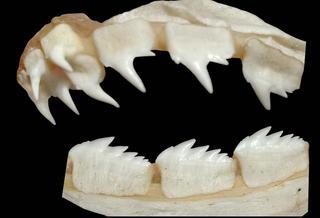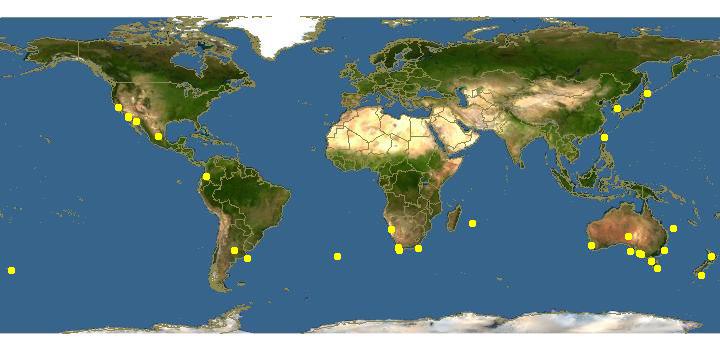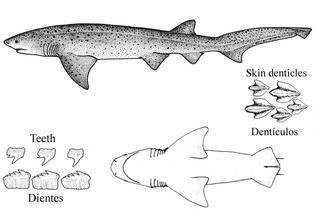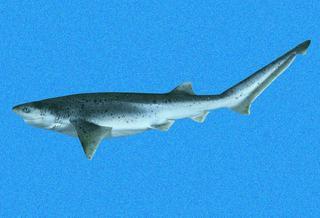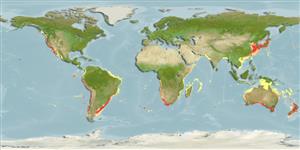|
| Links |
We parsed the following live from the Web into this page. Such content is managed by its original site and not cached on Discover Life. Please send feedback and corrections directly to the source. See original regarding copyrights and terms of use.
- Australian Faunal Directory
- FishBase
|
|
español |
|
|
Overview | |
Main identification features
Seven large gill slits, none over pectoral base; head and snout wide, rounded; eyes small; upper teeth small, with 1 large oblique point; lower teeth large, wide with saw-like row of small teeth along top; 1 dorsal fin, at rear of body near tail; tail with small lower lobe.
Grey above, white below; many small black spots scattered over body and fins.
Size: 300 cm.
Habitat: demersal and midwater; sandy bottoms.
Depth: 0-570 m.
A subtropical to warm temperate species from the Pacific, both sides of the Atlantic and the south-west Indian Ocean; enters the northern (Baja and the Gulf of California) and southern (Colombia to Peru) fringes of our region.
Attributes
Abundance: Common.
Cites: Not listed.
Climate Zone: North Temperate (Californian Province &/or Northern Gulf of California); Northern Subtropical (Cortez Province + Sinaloan Gap); Equatorial (Costa Rica to Ecuador + Galapagos, Clipperton, Cocos, Malpelo); South Temperate (Peruvian Province ); Antitropical (North and South temperate).
Depth Range Max: 570 m.
Depth Range Min: 0 m.
Diet: bony fishes; sharks/rays; sea snakes/mammals/turtles/birds.
Eastern Pacific Range: Northern limit=33; Southern limit=-9; Western limit=-118; Eastern limit=-78; Latitudinal range=42; Longitudinal range=40.
Egg Type: Live birth; No pelagic larva.
Feeding Group: Carnivore.
FishBase Habitat: Demersal.
Global Endemism: Circumtropical ( Indian + Pacific + Atlantic Oceans); East Pacific + Atlantic (East +/or West); East Pacific + all Atlantic (East+West); TEP non-endemic; West + East Pacific (but not Central); "Transpacific" (East + Central &/or West Pacific); All species.
Habitat: Mud; Reef associated (reef + edges-water column & soft bottom); Sand & gravel; Rocks; Soft bottom (mud, sand,gravel, beach, estuary & mangrove); Reef (rock &/or coral); Reef and soft bottom; Water column.
Inshore Offshore: Inshore; Inshore Only.
IUCN Red List: Data deficient; Listed.
Length Max: 300 cm.
Regional Endemism: Continent only; Continent; Tropical Eastern Pacific (TEP) non-endemic; Eastern Pacific non-endemic; California + Peruvian provinces, primarily; Temperate Eastern Pacific, primarily; All species.
Residency: Resident.
Salinity: Marine; Marine Only.
Water Column Position: Bottom; Near Bottom; Bottom + water column;
|
|
|
Names | |
|
|
|
Links to other sites | |
|
|
|
References |
- Béarez, P., 1996., Lista de los Peces Marinos del Ecuador Continental., Revista de Biologia Tropical, 44:731-741.
- Compagno, L.J.V., 1999., Checklist of living elasmobranchs. In Hamlett W.C. (ed.) Sharks, skates, and rays: the biology of elasmobranch fishes., The John Hopkins University Press:471-498.
- Compagno, L.J.V., 1984., Sharks of the World. An annotated and illustrated catalogue of sharks species known to date. Part 1. Hexanchiformes to Lamniformes. FAO Species Catalogue., FAO Fish. Synop. No 125, 4(1):1-249.
- Eschmeyer , W. N. , Herald , E. S. and Hamman, H., 1983., A field guide to Pacific coast fishes of North America from the Gulf of Alaska to Baja California. Peterson Field Guide Ser. 28., Houghton Mifflin:336pp.
- Findley, L.T., Hendrickx, M.E., Brusca, R.C., van der Heiden, A.M., Hastings, P.A., Torre, J., 2003., Diversidad de la Macrofauna Marina del Golfo de California, Mexico., CD-ROM versión 1.0. Projecto de la Macrofauna del Golfo . Derechos reservados de los autores y Conservación Internacional.
- Fischer , W. , Krup , F. , Schneider , W. , Sommer , C. , Carpenter , K. E. and Niem, V. H., 1995., Guia FAO para la Identificacion de Especies de para los fines de la Pesca. Pacifico Centro-Oriental. Volumen II. Vertebrados - Parte 1., FAO2:647-1200.
- Jimenez-Prado, P., Béarez, P., 2004., Peces marinos del Ecuador continental / Marine fishes of continental Ecuador., SIMBIOE/NAZCA/IFEA tomo 1 y 2.
- Love, M.S., Mecklenburg, C.W., Mecklenburg, T.A., Thorsteinson, L.K., 2005., es of the West Coast and Alaska: a checklist of North Pacific and Artic Ocena species from Baja California to the Alaska-Yukon border., U.S. Department of the Interior, U.S. Geological Survey, Biological Resources Division, 288pp.
- Perón, F., 1807., Voyage de Découvertes aux Terres Australes, exécuté par ordre de sa majesté l'Empereur et Roi, sur les Corvettes la Géographe, la Naturaliste et la Goulette le Casuarina, pendant les années 1800, 1801, 1803 et 1804. Paris., Voyage Terres Australes, 1:1-496.
|
|
|
Acknowledgements | |
I thank Ashley MacDonald and John Pickering, University of Georgia, for technical support in building this page.
|
|
| Supported by | |
|
Following modified from Australian Faunal Directory
|
Top | See original
| &pull 20q v5.145 20180528: Error 301 Moved Permanently http://biodiversity.org.au/afd/taxa/266c76ff-7b36-418a-83e2-718c937de359 |
|
Following modified from FishBase
|
Top | See original
http://www.fishbase.org/Summary/speciesSummary.php?genusname=Notorynchus&speciesname=cepedianus ---> http://192.134.151.83/Summary/speciesSummary.php?genusname=Notorynchus&speciesname=cepedianus
http://192.134.151.83/Summary/speciesSummary.php?genusname=Notorynchus&speciesname=cepedianus ---> https://fishbase.mnhn.fr/Summary/speciesSummary.php?genusname=Notorynchus&speciesname=cepedianus
https://fishbase.mnhn.fr/Summary/speciesSummary.php?genusname=Notorynchus&speciesname=cepedianus ---> https://fishbase.mnhn.fr/summary/Notorynchus-cepedianus.html
Notorynchus cepedianus, Broadnose sevengill shark : fisheries, gamefish, aquarium

You can
sponsor
this page
Common name (e.g. trout)
Genus + Species (e.g. Gadus morhua)
-

-
About this page
-
Languages
-
User feedbacks
-
Citation
-
Uploads
-
Related species
-


 Broadnose sevengill shark
Add your observation in
Fish Watcher
Upload your
photos
and
videos
Broadnose sevengill shark
Add your observation in
Fish Watcher
Upload your
photos
and
videos
Pictures
|
Videos |
Google image
 Notorynchus cepedianus
Notorynchus cepedianus
Picture by
Murch, A.
Elasmobranchii (sharks and rays) >
Hexanchiformes
(Frill and cow sharks) >
Hexanchidae
(Cow sharks)
Etymology:
Notorynchus:
Etymology not explained, presumably
noto
(
s
) (Gr.), back, possibly referring to posterior placement of single dorsal fin;
rhynchus
(L.), snout, possibly referring to broad, depressed snout. (
See ETYFish
)
;
cepedianus:
-anus
, Latin adjectival suffix that means, when attached to a name, âbelonging toâ: Bernard Germain Ãtienne de La Ville-sur-Illon, comte de [count of] La Cepède (also spelled as La Cépède, Lacépède and Lacepède, 1756-1825), author of
Histoire Naturelle des Poissons
(1798-1803) and Péronâs âillustrious masterâ (translation) in ichthyology. (
See ETYFish
)
.
Environment: milieu / climate zone / depth range / distribution range
Ecology
Marine; brackish; demersal; depth range 0 - 570 m (Ref.
26346
), usually ? - 80 m (Ref.
5578
). Subtropical; 56°N - 55°S, 131°W - 177°E (Ref.
54680
)
Circumglobal: In tropical to temperate waters; except North Atlantic and Mediterranean Sea. Southwest Atlantic: southern Brazil to northern Argentina. Southeast Atlantic: Namibia to East London, South Africa (Ref.
5578
). Western Pacific: southern Japan to New Zealand. Eastern Pacific: British Columbia, Canada to Chile. Record from India maybe erroneous.
Length at first maturity / Size / Weight / Age
Maturity: L
m
200.0
, range 192 - 208 cm
Max length : 300 cm TL male/unsexed; (Ref.
5578
); common length : 150 cm TL male/unsexed; (Ref.
6077
); max. published weight: 107.0 kg (Ref.
9987
); max. reported age: 49 years (Ref.
27952
)
Dorsal
spines
(total): 0;
Dorsal
soft rays
(total): 0;
Anal
spines
: 0;
Anal
soft rays
: 0;
Vertebrae
: 123 - 157. A large seven-gilled cowshark (Ref.
5578
) with a wide head, short and blunt snout, and fusiform body. Dorsal fin small, origin may vary from over insertion of pelvic fins to over free rear tips of pelvic fins. Anal fin smaller than dorsal fin. Tooth count 15-16/13. Reddish-brown to silvery-grey or olive-brown with numerous small black spots on body and fins; cream below (Ref.
5578
).
Found on the continental shelf, often in shallow water (Ref.
247
). Occurs close inshore, in bays and estuaries (Ref.
6871
), with larger individuals ranging into deeper waters offshore and deep channels in bays (Ref.
247
). Usually cruising steadily and slowly near the bottom (sometimes in water as shallow as a meter), but sometimes at the surface (Ref.
247
). Can dash at speed when attacking prey (Ref.
247
). Feeds on anything, including other sharks, rays, chimaeras, bony fish, hagfish, dolphin and porpoise meat, seals, shark egg cases, sea snails and mammalian carrion, including rats and humans (Ref.
5578
). Ovoviviparous (Ref.
50449
), with 82 to 95 young in a litter (Ref.
31395
). Aggressive when provoked, and regarded as potentially dangerous to people in open waters (Ref.
247
). It has attacked divers in captivity and may be involved in a few shark attacks off California and South Africa (Ref.
247
). Often caught by anglers from the shore (Ref.
6574
). Utilized for human consumption, its skin for leather, and its liver as a source of oil (Ref.
247
).
Ovoviviparous, embryos feeding solely on yolk (Ref.
50449
), with number of young reaching 82 in a litter. Gravid females apparently drop their young in shallow bays. Size at birth between 40 (Ref.
26346
) and 53 (Ref.
247
) cm. Distinct pairing with embrace (Ref.
205
). Gestation period 12 months. The reproductive cycle appears to be biennial (Ref.
45445
).
Compagno, L.J.V.
, 1984. FAO Species Catalogue. Vol. 4. Sharks of the world. An annotated and illustrated catalogue of shark species known to date. Part 1 - Hexanchiformes to Lamniformes. FAO Fish. Synop. 125(4/1):1-249. Rome, FAO. (Ref.
247
)
IUCN Red List Status (Ref.
130435
)
Vulnerable (VU)
(A2bd); Date assessed:
28 February 2015
CITES
Not Evaluated
Not Evaluated
Threat to humans
Traumatogenic (Ref.
247
)
Human uses
Fisheries: commercial; gamefish: yes; aquarium: public aquariums
FAO - Fisheries:
landings
,
species profile
; Publication:
search
|
FishSource
|
Sea Around Us
More information
Countries
FAO areas
Ecosystems
Occurrences
Introductions
Stocks
Ecology
Diet
Food items
Food consumption
Ration
Common names
Synonyms
Metabolism
Predators
Ecotoxicology
Reproduction
Maturity
Spawning
Spawning aggregation
Fecundity
Eggs
Egg development
Age/Size
Growth
Length-weight
Length-length
Length-frequencies
Morphometrics
Morphology
Larvae
Larval dynamics
Recruitment
Abundance
BRUVS
References
Aquaculture
Aquaculture profile
Strains
Genetics
Electrophoreses
Heritability
Diseases
Processing
Nutrients
Mass conversion
Collaborators
Pictures
Stamps, Coins Misc.
Sounds
Ciguatera
Speed
Swim. type
Gill area
Otoliths
Brains
Vision
Tools
Bio-Quiz
|
E-book
|
Field guide
|
Identification keys
|
Length-frequency wizard
|
Life-history tool
|
Point map
|
Classification Tree
|
Catch-MSY
|
Special reports
Check for Aquarium maintenance
|
Check for Species Fact Sheets
|
Check for Aquaculture Fact Sheets
Download XML
Summary page
|
Point data
|
Common names
|
Photos
Internet sources
AFORO (otoliths) |
Aquatic Commons
|
BHL
|
Cloffa
|
BOLDSystems
|
Websites from users
|
Check FishWatcher
|
CISTI
|
Catalog of Fishes
:
genus
,
species
|
DiscoverLife
|
ECOTOX
| FAO - Fisheries:
landings
,
species profile
; Publication:
search
|
Faunafri
| Fishipedia |
Fishtrace
| GenBank:
genome
,
nucleotide
|
GloBI
|
Google Books
|
Google Scholar
|
Google
|
IGFA World Record
|
MitoFish
|
National databases
|
Otolith Atlas of Taiwan Fishes
|
PubMed
| Reef Life Survey | Socotra Atlas |
Tree of Life
| Wikipedia:
Go
,
Search
| World Records Freshwater Fishing |
Zoological Record
Estimates based on models
Preferred temperature (Ref.
123201
): 7.5 - 19.2, mean 14.2 °C (based on 122 cells).
Phylogenetic diversity index (Ref.
82804
): PD
50
= 1.0781 [Uniqueness, from 0.5 = low to 2.0 = high].
Bayesian length-weight: a=0.00240 (0.00102 - 0.00563), b=3.14 (2.93 - 3.35), in cm total length, based on LWR estimates for this (Sub)family-body shape (Ref.
93245
).
Trophic level (Ref.
69278
): 4.7 ±0.2 se; based on diet studies.
Resilience (Ref.
120179
): Very Low, minimum population doubling time more than 14 years (rm=0.026; K=0.25; tm=16; tmax=32; Fec=82-95).
Fishing Vulnerability (Ref.
59153
): High vulnerability (57 of 100).
Climate Vulnerability (Ref.
125649
): High vulnerability (64 of 100).
Price category (Ref.
80766
):
Low
.
Nutrients (Ref.
124155
): Calcium = 13.3 [2.9, 63.2] mg/100g; Iron = 0.671 [0.165, 1.979] mg/100g; Protein = 20.1 [17.9, 22.2] %; Omega3 = 0.275 [0.123, 0.632] g/100g; Selenium = 43.1 [11.1, 117.0] μg/100g; VitaminA = 5.25 [1.65, 16.47] μg/100g; Zinc = 0.328 [0.161, 0.626] mg/100g (wet weight);
Back to Search
Random Species
Back to Top
Accessed through:
Not available
FishBase mirror site :
localhost
Page last modified by :
mrius-barile
- 20 July 2016
Fatal error
: Uncaught ArgumentCountError: Too few arguments to function checkEcotox(), 1 passed in /var/www/html/summary/speciessummary.php on line 2304 and exactly 3 expected in /var/www/html/includes/speciessummary.lib.php:2579 Stack trace: #0 /var/www/html/summary/speciessummary.php(2304): checkEcotox() #1 {main} thrown in
/var/www/html/includes/speciessummary.lib.php
on line
2579
|
Updated: 2024-05-23 05:59:05 gmt
|
